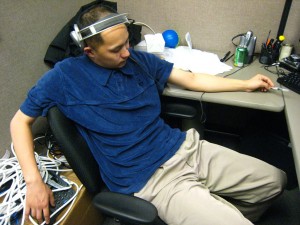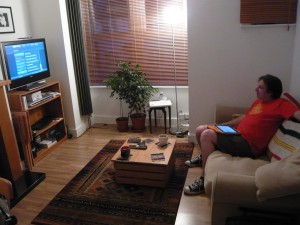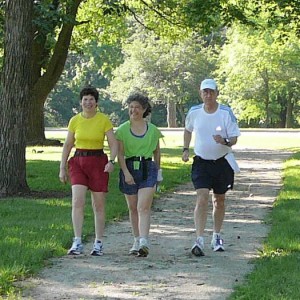
Many people today have sedentary jobs, sitting at their desks all day (Photo: Star511 at Flickr/Creative Commons)
Are the technologies and comforts of modern society making us inactive and lazy?
In a recent study published by the British medical journal, the “Lancet,” in 2008 physical inactivity led to the death of nearly 5.3 million people across the world – that’s one in every 10 deaths.
It’s been reported that the problem of physical inactivity is growing in pandemic proportions.
Dr. Michael Joyner, a physiologist at the Mayo Clinic, writing in “The Journal of Physiology,” expands on concerns about the lack of physical activity and says that inactivity or a lack of exercise should be treated as if it were a medical condition.
Joyner says that the idea of inactivity’s impact on our health has been emerging in the medical community for at least the last 10 years.
“We’re looking at the exercise, inactivity/activity all wrong,” he says. “We’ve defined the normal state as the physically inactive state when in fact the normal state is the active state and so many of our lifestyle-related diseases and chronic diseases have their root cause in physical inactivity.”
Joyner also says that innovative treatments for many of these health problems center on increasing people’s physical activity.
He suggests that inactivity be “medicalized,” similar to what has been done to treat other health issues such as addiction and smoking. That way, Joyner says, new treatments can be developed including those that focus on behavioral modifications and physical activity.
Taking it further, Joyner suggests that nations take public health measures to help promote physical activity.

Instead of spending hours sitting on your couch watching TV, why not get up and go for a walk? (Photo: Jessica Spengler via Flickr/Creative Commons)
So why has a lack of physical activity become such a problem? Joyner says there are what he describes as “death spirals” occurring simultaneously that encourages us to be less physically active and eat too much.
For example, he points out, that instead of getting their children to go outside and play, many parents today simply allow them to sit around the house to watch TV or play video games. And, rather than encourage them to walk or ride their bicycles to school, some parents just drive their kids to and from their school’s doorstep.
Adults too have been sucked into the inactive lifestyle, according to Joyner. He says that more people today are working in urban environments, where it might be difficult to be physically active all day long.
“In places like the United States and other developed countries, we’re sort of prisoners to our cars and so forth,” Joyner said.
Joyner says that less activity along with all of the rich, calorie-laden food that’s quickly available and ready to eat can combine into a real problem.
That problem, he says, includes non-communicable diseases like diabetes, hypertension, obesity, heart disease, stroke, and depression, which have been affecting the developed world and are increasingly affecting countries that are in economic transition.
According to Joyner, the diseases are all linked to lower levels of physical activity.
On the other hand, he says, people who maintain an active lifestyle are relatively protected from the conditions. Joyner also points out that those who already have the diseases can get better when they become more physically active.
Joyner warns that if nothing is done to address inactivity, people are going to continue to get sick, their kidneys and blood vessels will fail, and they will need plenty of costly medical treatments.

Getting physically active can be as easy as taking a brisk walk every day. (Photo: Trailnet via Flickr/Creative Commons)
Joyner says that if physical inactivity were treated as a medical condition, doctors and other providers can be better educated about the benefits of physical activity and become much more aware of the value of prescribing exercise instead of drugs.
That, he says, could also encourage the development of more formal rehabilitation programs that include innovative cognitive and behavioral therapy.
If after reading this you recognize that you aren’t as physically inactive as you should be, Joyner says a number of studies have shown that 150 minutes a week of “moderately vigorous physical activity” offers a level of protection from potentially deadly diseases and conditions.
“The easiest way to do that,” Joyner says, “is to go out on five 30-minute walks a week, and push it a little bit.” But he warns not to push too hard, “just a good brisk walk.” If you find it difficult to do 30 minutes at a time, Dr. Joyner suggests that you can break up the walking sessions into three 10-minute segments and only do what you can handle.
For those people who have been inactive for a long period of time, gained some weight or have developed medical problems, getting physically active can be an even more difficult challenge.
If you have high blood pressure, high cholesterol, are a smoker or are over 45 years of age, Joyner says that you might want to see your physician before starting a physical activity or exercise program.
But don’t be discouraged, Joyner adds that in general, data shows that a majority of people can go out and walk to their level of discomfort without a lot of risk, meaning that most can begin a walking program relatively easy.
Dr. Michael Joyner is with us for this week’s radio edition of Science World and he talks about the dangers of being physically inactive and most importantly what we can do to help ourselves get and stay active and healthy.
Listen to the interview below.
[audio://blogs.voanews.com/science-world/files/2012/08/081712-Science-World-Interview-Danger-of-Physical-Inactivity-Dr.-Michael-Joyner-Mayo-Clinic.mp3|titles=081712 Science World Interview – Dangers of Physical Inactivity – Dr. Michael Joyner, MD – The Mayo Clinic – Web]




















Thanks,hope to receive more health tips
I believe this is pretty much what is happening to me, thank you for make me aware of this, It’ll be my new commitment to exercise more everyday.
Good Read – 5 Stars from me!
I totally agree with Dr. Joyner.
The benefits of physical activity can keep us in good shape and health. At least 30 minutes of moderately vigorous physical activity every day can keep us far away from potentially deadly diseases and conditions.
The simplest activity for us to do is going for a walk, and the most difficult is to go for a walk every day.